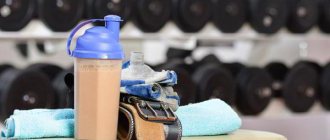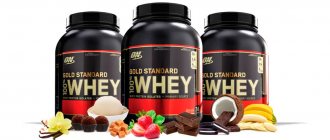Creatine is a nitrogen-containing carboxylic acid that is involved in energy metabolism in nerve and muscle cells. Its main beneficial effect is to supply muscles with energy during high-intensity training, including strength training and sprinting.
The effect is due to the fact that in muscles creatine binds with phosphorus to form phosphocreatine. Increasing the latter by about 20% helps the body withstand extreme loads longer and recover faster between approaches. As a result, the athlete becomes more productive and can better perform repetitive exercises during training. This helps increase strength and enhance muscle growth.
Creatine monohydrate is the most common in sports nutrition, but this supplement has 14 other chemical forms. Each has its own characteristics and recommendations for use. Therefore, in order to decide which creatine is best to buy, you should first familiarize yourself with all the forms that exist.
We advise you to study: “How to take creatine correctly.”
Creatine monohydrate
When considering the question of which type of creatine is better to choose, we can say with certainty - monohydrate. Even if you are not sure, you can't go wrong with this form. Monohydrate is the most studied and inexpensive. In addition to creatine, such supplements also contain 12% water. Very fine grinding ensures almost complete dissolution and best absorption.
If we talk about which creatine monohydrate is better, we can cite the following supplements:
- Creatine Drive Black from Nutrex (USA).
- Creatine Monohydrate from Be First (Russia).
- Performance Creatine from San (USA).
- Creatine 6000 from FIT-RX (Russia).
- Creatine from Maxler (Germany).
Cre 9
GYMortal CRE 9 from the Hungarian manufacturer Nutriversum is a unique energy supplement in powder form that includes seven varieties of creatine, as well as plant extracts, citrulline malate and a transport system based on high-quality carbohydrates. This is simply an indispensable complex for those who want to quickly increase muscle performance and improve performance in the gym.
Creatine is known to be the most researched and incredibly effective sports supplement. Nutriversum specialists, understanding the importance of creatine for athletes, have developed a special creatine complex containing 7 types of this supplement. This allows you to greatly increase the effectiveness of taking the supplement and increase strength in training.
Important properties of CRE 9 from GYMortal:
- increases endurance
- increases exercise intensity
- has a powerful energetic effect
- increases strength indicators
- promotes active muscle building
- improves the secretion of anabolic hormones
- reduces fatigue during training
- reduces the secretion and concentration of lactic acid
In addition to a powerful creatine matrix, GYMortal CRE 9 contains citrulline malate, an amino acid that has a restorative and anti-catabolic effect. The composition also includes Siberian ginseng extract, a powerful adaptogen, which, among other things, has a stimulating effect and increases performance.
In addition, the composition of CRE 9 from Nutriversum is enriched with a carbohydrate matrix based on maltodextrin, fructose and modified starch. These components play the role of a transporter, facilitating the rapid and efficient transfer of creatine into muscle cells. Thus, when you take a serving of GYMortal CRE 9, you receive an innovative creatine blend enriched with citrulline malate and ginseng extract and complemented by a powerful transport system. This is one of the most effective supplements you will ever try.
Many athletes have appreciated the sports supplement GYMortal CRE 9 from Nutriversum. Try unsurpassed European quality at a competitive price!
Composition of GYMortal CRE 9
Contents per serving (1 scoop = 10 g):
- Micronized creatine monohydrate - 1000 mg
- Buffered creatine monohydrate - 1000 mg
- Creatine phosphate – 1000 mg
- Creatine citrate – 500 mg
- Creatine pyruvate – 500 mg
- Creatine hydrochloride – 500 mg
- Tricreatine malate – 300 mg
- Calcium alpha-ketoglutorate – 100 mg
- Dextrose - 1.6 g
- Maltodextrin - 1.6 g
- Fructose - 0.4 g
- Waxymaize (modified starch) - 0.4 g
- Siberian ginseng (Eleutherococcus root extract): - 100 mg ginsenoside - 0.8 mg
- L-citrulline – 56 mg
Ingredients: dextrose, maltodextrin, creatine phosphate, creatine monohydrate, micronized creatine monohydrate, creatine citrate, creatine pyruvate, creatine hydrochloride, fructose, waxy starch (modified starch), tricreatine malate, calcium alpha-ketoglutorate, Eleutherococcus (Eleutherococcus senticosus), powder root , L-citrilline malate (1:1), flavors, sweetener (sucralose), color (PONCO 4R).
Recommendations for use: Mix one measuring spoon per 250 ml of liquid, take 30 minutes before training.
Creatine citrate
Once monohydrate became popular, another form of creatine appeared on the market - citrate. Its main difference was citric acid. During the production process, its molecules are attached to creatine molecules. The goal is to increase the amount of energy produced by creatine. This is achieved due to the fact that citric acid participates in the tricarboxylic acid cycle (Krebs cycle), and its result is always the production of adenosine triphosphate (ATP), a source of energy for the body. Compared to monohydrate, citrate is also slightly more soluble in water.
Creatine malate - dosage
What is the recommended daily dose of creatine malate?
There are many opinions associated with creatine consumption. Recent studies, however, confirm that the most effective dose is 5 g per day.
Are there saturation phases?
There is no need to do the so-called saturation phases. The body gradually becomes saturated with creatine and will not be able to absorb doses of 15-30 g per day, as advocates of using saturation phases recommend. From a consumer perspective, this will be a waste product of the supplement that will be excreted in urine.
How do you take creatine malate
The best solution seems to be to consume creatine with breakfast on non-training days and immediately after training on training days.
For people who exercise twice a day, you can increase the dose from 5 to 19 grams per day. One serving after each workout.
There are also no contraindications to consuming creatine with juices and even coffee. Creatine malate is highly soluble in water, so there will be no problems with taking the supplement.
Creatine hydrochloride
One of the latest developments in sports nutrition is creatine hydrochloride. This form is obtained by attaching a hydrochloride group to creatine to form the corresponding salt. In medicine, a similar simple method is used to increase the bioavailability and effectiveness of active ingredients. The hydrochloride has:
- improved solubility;
- increased bioavailability (more effective at lower dosages, has fewer side effects and does not put a strain on the liver and kidneys);
- accelerated absorption (muscles receive nutrients faster).
According to some studies, the hydrochloride form combines better with caffeine, which is why it is often included in pre-workout supplements.
We recommend studying: “How to take caffeine to improve athletic performance and lose weight.”
Which creatine is better - monohydrate or hydrochloride? For those who have digestive problems or allergies from monohydrate, it is better to choose hydrochloride. It does not cause bloating or digestive upset, and also provides the maximum benefits of a supplement such as creatine.
Combined use of creatine with other pharmaconutrients[edit | edit code]
- Creatine HMB
- Creatine and beta-alanine
- Buffer creatine
Combined use of CM and sodium bicarbonate[edit | edit code]
The combined use of CM and sodium bicarbonate (SN) was studied by JJBarber et al[40]. The prerequisites for such a combination are laid by a number of previous studies, which showed that short-term use of creatine increases physical fitness by enhancing ATP resynthesis [41][42][43], and short-term use of BN increases the buffering capacity of body fluids (muscles, in particular), reducing fatigue and increasing exercise tolerance[44][45][46]. The difference in the points of action (mechanisms) of the two substances has the potential to provide additional ergogenic benefits. Although it was already shown in the work of A. Mero et al [47] that the combination of creatine and BN increases physical fitness in swimmers at a 100-meter distance, there was a significant drawback in this study - the absence of a group using only creatine. In the work of JJBarber and his colleagues, this shortcoming was eliminated. Thirteen healthy trained men took part in a double-blind crossover study. All of them, at a certain (wash-out) interval, participated in the following options for taking nutritional supplements: (a) placebo (20 g maltodextrin); (b) creatine (20 g + 0.5 g/kg maltodextrin); (c) creatine + sodium bicarbonate (20 g creatine + 0.5 g/kg BN). Each study option lasted 2 days, followed by a washout period of 3 weeks. During testing, the following indicators were assessed: peak power, average power, relative peak power, bicarbonate concentration. The test involved six 10-second repeated sprints on a bicycle ergometer (Wingate sprint tests) with a 60-second rest period between sprints. Peak power under the influence of creatine significantly increased by 4% compared to placebo, and with the combined use of creatine and BN this advantage increased to 7%. The concentration of BN in blood plasma in the group with combined intake of creatine and BN increased by 10% compared to other groups. The authors conclude that a combination of creatine and sodium bicarbonate resulted in a greater increase in peak and average power and a reduction in relative peak power decline with repetition of exercise compared to creatine alone. Accordingly, this combination may provide additional benefits for athletes during high-intensity intermittent training.
Other Forms of Creatine
Micronized Creatine
. Regular monohydrate, but subjected to a micronization process. In such an additive, the particle size of the powder is 20 times smaller than in a regular one, and this ensures faster dissolution and better absorption by the body. If we consider which creatine is the most effective, then we can say that micronized.
Creatine tartrate.
Does not have any special advantages over monohydrate. The main advantage is that it retains its properties longer, which is due to the presence of tartaric acid in the composition, which is often used in the manufacture of chewable lozenges, effervescent and regular tablets, and capsules.
Magnesium creatine.
Magnesium molecules in the supplement improve its absorption, since it is involved in the process of converting creatine phosphate into ATP.
We advise you to study: “What are the benefits of magnesium for athletes: differences from magnesium B6 and rules of administration.”
Creatine-glutamine-taurine.
A combination of three substances: creatine, glutamine and taurine. The combination was not chosen by chance, but on the basis that glutamine and creatine, together with taurine, will enter the muscles faster and be retained in them longer.
Buffered creatine.
It is considered safer and more effective compared to monohydrate. Its peculiarity is that it matches the pH level in the stomach. This allows creatine to not be broken down into creatinine, which increases the nutritional value of the supplement.
Creatine HMB.
Quite a new product on the market, but already has positive reviews. It contains creatine and HMB (beta-hydroxy beta-methylburate), which, after entering the body, are separated and absorbed separately. Among all types of creatine, this is the safest and does not have any effect on the stomach.
Creatine ester.
High-tech product with increased biological value. Taking this supplement dramatically increases the positive effects of creatine on the body. This is due to the fact that the attached ester group facilitates the passage of acid through the walls of intestinal cells and muscles.
Creatine in effervescent tablets (effervescent creatine).
A form with improved absorption, which is achieved due to the presence of citric acid and bicarbonate in the composition. When mixed with water, creatine separates from other components in the tablet and is absorbed in its pure form.
Creatine titrate.
The titrate provides better dissolution in water, but unlike effervescent tablets, it does not have an effervescent effect. The action is ensured by the fact that during the process of stirring the additive, the titrate affects hydrogen ions. Although there are no supporting facts, it is believed that this way the substance will be better absorbed.
Don't miss interesting news and events in the telegram channel: https://tlgg.ru/fitbarnews
How long should you take creatine?
The regimen for taking a creatine supplement is as follows:
- For the first 5 days, you should take creatine 25 grams per day, dividing the doses into 5 times of 5 grams: in the morning and 20 minutes before meals during the day. This will dramatically increase the concentration of amino acids in muscle tissue.
- Then you need to take the supplement 3-5 grams daily for 40 days. You can choose to take it: either immediately after waking up or an hour after training.
Attention! If you don't have a scoop, remember that there are 5 grams of creatine in one teaspoon.
Like most amino acids, creatine is most effective when taken as a course. Therefore, you should take the supplement in a course for 45 days, then take a break for about 4 weeks, and then resume taking it. If you do not take breaks, the muscle tissue will get used to the increased dosage of the amino acid and stop responding to it.
Creatine powder can be mixed with water. After taking the supplement, you can drink a glass of juice - this will have a positive effect on digestibility.
Important! Choose supplements in powders rather than ready-made solutions. The fact is that upon contact with water, creatine monohydrate is destroyed, and taking solutions will not allow the body to receive the required dose of the amino acid.










